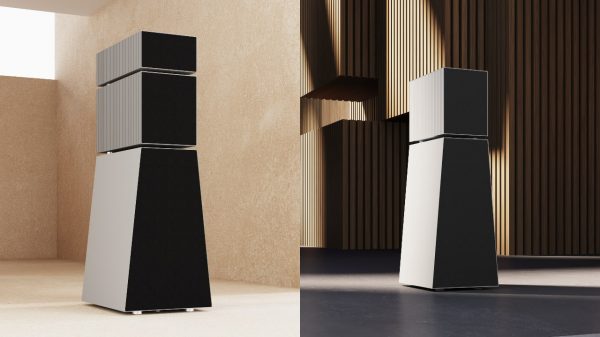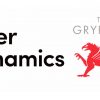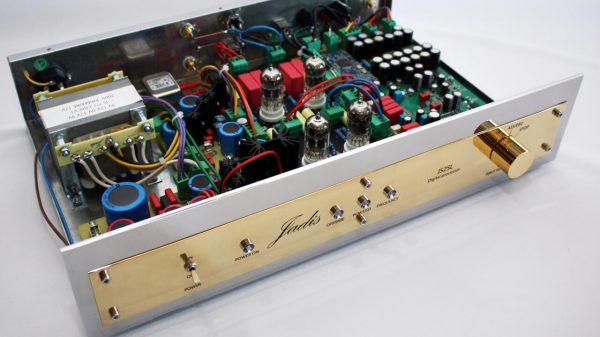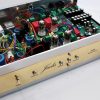Review by Tom Lyle (page 2 of 4)

Aavik claims that their Aavik Acoustics D-180 DAC has no “digital signature,” which results in music sounding “natural and authentic.” Unfortunately, although I have some of my favorite music stored as digital files that sound incredible, I also have many that don’t sound so good. As I have some vinyl record albums pressed in the US in the 1970s that sound like crap, I also have many digital files sourced from ripped CDs manufactured in the mid-80s that sound even worse. And like Aavik’s I-180, the D-180 won’t hide this fact from you.
On their website, Aavik says that their converter has digital circuits that use “the best” high-frequency parts and that they used “great care” in their setup. They went on to say that they employed “time-aligned, ultra-short, 4-layer printed circuit board traces to “preserve the natural and pristine sound quality of the wide and complex range of different signals.”
The D-180’s circuits are also fitted with “ultra-low jitter onboard clocks.” All DAC circuits are isolated with “13 onboard, separate, low-noise, high-voltage regulators”, each feeding only one stage of the signal handling to minimize timing errors. In addition, the USB input is “galvanically isolated,” which reduces that amount of noise.
As far as the DAC section of the D-180, its digital inputs are re-sampled and re-clocked before sending it to its output DAC chips. Some might not know what the heck “differential floating topology with virtual ground” is.
Still, it isolates the signal path from other sources of ground noise and signal-induced ground modulation. Those terms are new to me, too, but that’s when I rely on the saying coined, at least in part, when discussing features like these. Everything matters when designing a high-end component.
In my listening room, the sound quality that resulted from the above was a converter that sounded ultra-transparent to the source, more than any other converter that I heard in or around its price. It seemed as if the only purpose of the Aavik Acoustics D-180 was to read the digital signal that it was fed as accurately as technically possible and convert it into a music signal as accurately as technically feasible.
Of course, $7,200 isn’t chump change. But for the money, I was amazed at what I heard coming from this DAC’s analog outputs.

With the Aavik Acoustics D-180 in my system, most of the music that ultimately came from my speakers sounded marvelous. In short, it sounded like music. So, of course, when I played some of the 16-bit/44.1kHz files made from ripping CDs manufactured in the mid-1980s, it wasn’t a big surprise that many of them still sounded like crap. And I guess that’s a good thing: garbage in, garbage out.
Thankfully, the opposite was also true when I played decent files, such as a rip of the SACD of David Bowie’s Heathen on Sony / Columbia that was pressed in Europe. I’ve always been a fan of Bowie’s music, but the material I always liked best and listened to the most was his 1970s output. As time went on, I began to appreciate his later work more and more, almost to the point where there were times when I favored no era more than any other.
David Bowie started working on Heathen before the September 11th attacks, and none of the tracks on the album refer specifically to those events or their aftermath. But in an interview, Bowie said that anyone, especially those like him who lived so close to it as his family did, could not help but be affected by it. So, yes, some of Heathen was influenced by 9/11, even if not explicitly.
I could go on and on about this great album! But this is not a David Bowie review. It’s a review of Aavik components! But it was the Aavik Acoustics D-180 converter that made me think so much of the meaning behind the music. The DSD files of this album is a perfect example of one reason I appreciate having a high-end audio system — capturing the gestalt of real instruments in a real space used to be the mantra of many audiophiles, but an audiophile like myself hardly listens to only those types of recordings that would be able to demonstrate that feature.
So, if a component can’t sort out a multi-track studio recording such as this one where David Bowie plays all the instruments on some tracks, it need not apply as a resident in my system. The D-180 did an excellent job at interpreting the intentions of David Bowie on this album when considering its price, which made this DAC even more impressive.
Often, I have trouble reviewing a digital converter in the same way as reviews done with other audio components. Discussing frequency extension, transients, etc., isn’t the only criteria I’m listening for when auditioning a DAC. If a DAC is reading the files transparently, then those traits should be the responsibility of the recording. Nevertheless, those traits are often a result of the skill of the analog section of the DAC, much goes on electronically before the signals get to that point. But I’ll admit that how a converter manages to create the signal that passes through the analog section is often a mystery to me!
A converter as good as the D-180 obviously must have a digital section where it can get out of the way to the point where it makes me believe that the signal has lost nothing in the conversion process. How a DAC does this is approached in different ways by different designers. A converter must act as an electronic magician of sorts, using its sleight of hand as it somehow can take a series of 1s and 0s and turn them into what I can then believe is an exact replica of what was encoded but is now a soundwave that can affect me emotionally. The Aavik D-180 reproduced the tracks on Heathen, sometimes a very complex recording, with layers of instruments and vocals, and create a sonic landscape that let me into David Bowie’s headspace.
Within my system, the Aavik D-180 was up against some stiff competition. My reference DAC costs more than two and a half times the price of the D-180. Last month I reviewed in Enjoy The Music a two-chassis converter that cost almost five times its price! Yet, I didn’t quickly listen to the Aavik D-180 for a bit and returned to my reference as soon as I could. The reason I didn’t was that there were many similarities between the Aavik converter and those other more costly components.
For example, my reference converter and the very pricey converter I recently reviewed can impart a dynamic distance between instruments — they can sonically separate two or more instruments, sounds, or voices that are the same volume and in the same area of its soundstage. Although not as pronounced, the Aavik D-180 had this same attribute as the other converters. The D-180 (and the I-180 integrated amplifier) sounds a little on the dark side of neutral. Still, given a choice, I’d rather have this slight lessening in the upper treble than the opposite, as a digital component that leans toward being bright. The same goes for a Class D amplifier, as often the highest treble isn’t its best quality. Of course, if I wasn’t such an audio snob, I might not have noticed this characteristic.
More than once, during the D-180’s stay, I played a DSD file of Sir Colin Davis’s reading of Sibelius’ Symphony No. 7 on the London Symphony Orchestra’s label, LSO Live. I’ve previously used this symphony as a musical example, mostly because I like it so much. It also happens to be a profoundly transparent recording or an orchestra. This one-movement symphony is Sibelius’ last. Other than his Symphony No. 4, I feel that it is the most modern-sounding composition.
Like this symphony, which lasts less than 25 minutes, I’ll keep my comments brief only because there isn’t much to say about the Aavik Acoustics D-180’s sound quality. This is a compliment. I’ve heard this work played through quite a few similarly priced DACs, and the D-180 exhibited no additive flavoring to the sound of this orchestral recording but also very few subtractive faults. For a DAC that costs less than $10k, there isn’t much to complain about and much to like.
The LSO’s strings on this recording sounded lush and distinctive, and the Aavik D-180 presented the orchestra’s right side with a heft that was one of the best I’ve from a DAC anywhere near its price. The soundstage, also distinctive in its scale and depth, also belied this DAC’s price. I’ve heard better DACs in my system, but they all cost much more than the D-180. I don’t think I’d be lying if I called this DAC a relative bargain. A terrific-looking, relative bargain.
I highly recommend the Aavik Acoustics D-180 as either an addition to one’s current system or, better yet, as a part of a complete Aavik system.
Next page: Aavik Acoustics S-180 Streamer / Network Player Review
D-180 Specifications
Digital:
Two BNC S/P-DIF (32 to 192 kHz samples, 24-bit
Two TOSLINK optical (32 to 192 kHz samples, 24-bit
USB fully isolated, UAC 2, asynchronous
USB: PCM 32 – 192 kHz samples, 24-bit, plus DSD 64 to DSD 128
Distortion: <0.005%
Output:
One pair of RCA output
Output: 4.5Vrms at 0dB
Output Impedance: 100 Ohms
Aavik Noise Reduction
Active Tesla Coils: 36
Active Square Tesla Coils: 104
Dither Circuitry: 5
Dimensions:14″ x 15″ x 15″ (HxWxD)
Weight: 12 lbs.
Price: $7,200






































